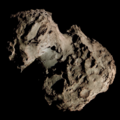8P/Tuttle
Appearance
Synodic rotation period | 11.4 hours | |
| (V–R) = 0.53±0.04 | ||
| Comet total magnitude (M1) | 14.6 | |
8P/Tuttle (also known as Tuttle's Comet or Comet Tuttle) is a
solar elongation of 26 degrees at approximately apparent magnitude 9.[6]
Two weeks later, on September 12, 2021, it was about 1.8 AU (270 million km) from Earth which is about as far from Earth as the comet can get when the comet is near perihelion.
Comet 8P/Tuttle is responsible for the Ursid meteor shower in late December.[7]
2008 perihelion
Under dark skies, the comet was a naked-eye object. On December 30, 2007, it was in close conjunction with the Triangulum Galaxy. On January 1, 2008, it passed Earth at a distance of 0.25282 AU (37.821 million km).[4] It was visible telescopically to Southern Hemisphere observers in the constellation Eridanus throughout February 2008.
Predictions that the 2007 Ursid meteor shower could have possibly been stronger than usual due to the return of the comet,[8] did not appear to materialize, as counts were in the range of normal distribution.
Contact binary
contact binary.[9][10] The comet nucleus is estimated at 4.5 km (2.8 mi) in diameter, using the equivalent diameter of a sphere having a volume equal to the sum of a 3 km × 4 km (1.9 mi × 2.5 mi) sphere.[4]
Additional images

Sun · Venus · Earth · Mars · Jupiter · Saturn · 8P/Tuttle
-
8P/Tuttle on December 3, 2007 fromMount Laguna, California
-
8P/Tuttle about 1.2 degrees from M33 on December 30, 2007.
References
- ^ K. Kinoshita (January 24, 2008). "8P/Tuttle". Comet Orbits.
- ^ "Horizons Batch for 8P/Tuttle on 2035-Apr-18" (Perihelion occurs when rdot flips from negative to positive). JPL Horizons. Retrieved September 12, 2021. (JPL K215/14 Soln.date: 2021-Sep-07)
- ^ "8P/Tuttle Orbit". Minor Planet Center. Retrieved January 13, 2021.
- ^ a b c d e "8P/Tuttle – JPL Small-Body Database Lookup". ssd.jpl.nasa.gov. Jet Propulsion Laboratory. Retrieved February 25, 2010.
- arXiv:2304.09309 [astro-ph.EP].
- ^ S. Yoshida (June 28, 2020). "8P/Tuttle". www.aerith.net. Retrieved July 20, 2020.
- ^ "Meteor Streams". ssd.jpl.nasa.gov. Jet Propulsion Laboratory. Retrieved July 28, 2014.
- Bibcode:2007JIMO...35..125J.
- Science. Retrieved October 25, 2008.
- ^ J. K. Harmon; M. C. Nolan; E. S. Howell; J. D. Giorgini (July 13–18, 2008). Comet 8P/Tuttle: Arecibo Radar Observations of the First Bilobate Comet (PDF). 10th Asteroids, Comets, Meteors. Baltimore, Maryland: Lunar and Planetary Institute.
External links
- 8P/Tuttle at the JPL Small-Body Database
- 8P/Tuttle – Seiichi Yoshida @ aerith.net
- 8P at Kronk's Cometography
- 8P/Tuttle time sequence
- Comet Tuttle Seen To Be Returning
- Comet 8P/Tuttle. Canary Islands, Tenerife. 06.01.2008 Archived March 11, 2016, at the Wayback Machine
- NASA Orbital Diagram








